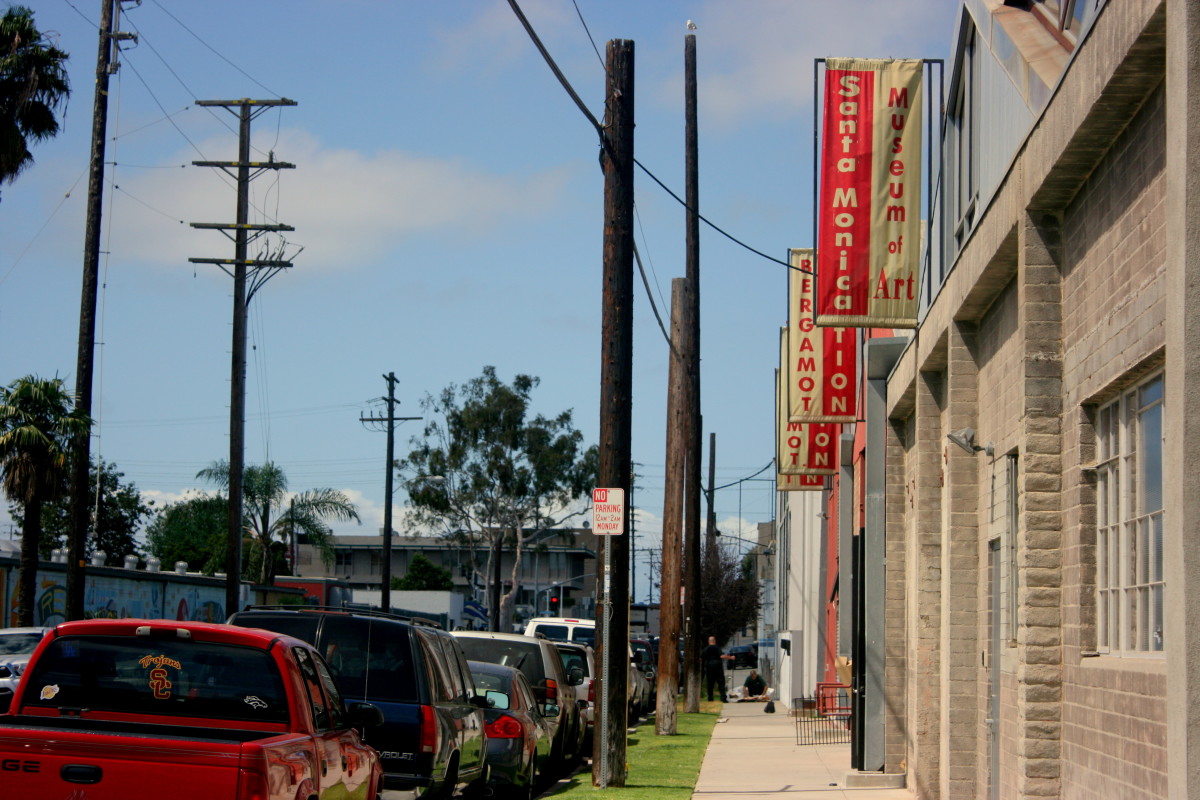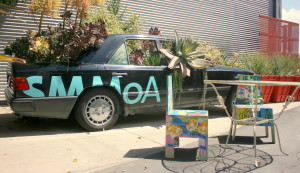
In the middle of Santa Monica’s Bergamot Station – a collection of about three dozen art galleries housed in repurposed industrial buildings – there is a patch of green space. It is small, about 900 square feet of grass and a few trees, hemmed in on all sides by a parking lot.
Just a few weeks ago, a group of students working with staff from the nearby Santa Monica Museum of Art (SMMoA), transformed the tiny island of green into a tree house of sorts, complete with a bamboo canopy and several small stages.

Standing in People Park – there’s a sign on the fence that says “People Park; No Dogs” – Asuka Hisa, SMMoA’s director of Education and Public Programs explained that, this summer, the area would host a series of programs, “some [organized] around the theme of imagining Santa Monica in the face of change.”
And change is coming soon to the former industrial corridor of Santa Monica.
Only a few hundred feet away, across the sea of cars crammed on the surface parking lot, construction is well underway on the Bergamot Station Expo light rail station, which expected to open to the public in early 2016.
Already there is an average of 27,360 daily commuters riding Expo, which currently runs between Culver City and Downtown Los Angeles. Officials originally estimated that Expo would reach 27,000 commuters a day by 2020.
The question facing Bergamot Station is how the cluster of art galleries in Santa Monica’s former industrial corridor will become a destination to travelers, and not just another stop along the way to the Downtown Santa Monica.
“It’s not going to sustain itself,” said Hisa. “These buildings were not meant to be permanent buildings.”
The City bought the roughly six-acre parcel – formerly a stop on the old Pacific Electric trolley line – in the 1980s to prevent it from being divided. While it would take decades, the City already anticipated the parcel would once again host a stop along a regional passenger train line.
In its current form, however, Bergamot Station belongs to a different time. In the decades after the Pacific Electric line shut down, the rails were used for freight and Bergamot became an area for light industry. It is virtually inaccessible by any other means but car. There are no bike racks. Cars fly by along Olympic Boulevard, which borders Bergamot Station to the north. Across the street sits a vacant factory, once home to Papermate.
Along Michigan Avenue, which marks the Station’s southern end, the old warehouse buildings form a fortress-like wall against a narrow sidewalk. And, at the moment, People Park is the only green space in the entire six acres.
[pullquote align=left]
“Delay is crippling,” Hisa said. “Everybody has to up their game. We want to serve our community in a greater way.”
[/pullquote]
That’s why, in June, the City Council will choose one of three development teams to overhaul the parcel, with the goals of preserving the galleries (all three plans include adding revenue-earning uses to subsidize the gallery rents), expanding the space for SMMoA, and creating more walkable, communal open space.
There will be a boutique hotel (the three teams have proposed hotels that range from 93 rooms and 125 rooms), restaurants, and possibly some creative office space, as well, to help keep the space active through the day and evening. There could even be a full-service bike center on site.
A redesign would also better connect Bergamot Station to the City’s planned greenway that would run from the station to the beach via Michigan Avenue.
“Bergamot Station can be this type of community activity through art ‘on 11’ (excuse the Spinal Tap reference), with the vision of this arts center at the next level,” said Hisa.
Over the years, she has grown accustomed to using the space outside the museum for programs, since the small building that

currently houses SMMoA doesn’t have the room.
Last year, SMMoA’s annual Spring Break project was called Skaters and Makers.
“We turned the courtyard into a skate park,” said Hisa. “We enlisted the help of architects and designers to work with teenagers to create two large ‘skate cubes,’ which are sculptural cubes that break up into 22 modular shapes (each) that can be configured into mini skate ramps.”
In 2012, there was the Knotwork Workshop: Let’s Make a Hammock project. Students created a two-level hammock at the People Park. The success of the hammock led to the concept of a more permanent tree house structure, Hisa said, which students constructed this past Spring Break.
Hisa is also an avid bicyclist and has helped coordinate the museum’s annual Tour da Arts, a festival celebrating art, bike-riding and music.
Recreating Bergamot Station into a more open, accessible space is exciting for Hisa and the museum’s future, but, she said, there is some anxiety among other tenants.
That anxiety was apparent at a public meeting earlier this month where developers presented their respective plans for transforming the area.

Much of the concern centered on the question of parking (all three plans expanded the amount of parking available) and the effects of construction on the current businesses (all three plans included tenant-retention goals of 100 percent).
A local anti-development group rallied its forces to oppose plans for the boutique hotel as well. At the meeting, opponents conflated the Bergamot Station project with the controversial – and now defunct – Bergamot Transit Village project across the street (no, the two projects are not related).
Hisa is worried that the confusion and the anxiety surrounding the Bergamot Station redesign could prove fatal to the project.
“Delay is crippling,” she said. “Everybody has to up their game. We want to serve our community in a greater way.”
For more information about the Bergamot redevelopment project, visit smgov.net/bergamot and send comments to econdev@smgov.net. For upcoming exhibitions and programs at the museum, visit smmoa.org/exhibitions.
